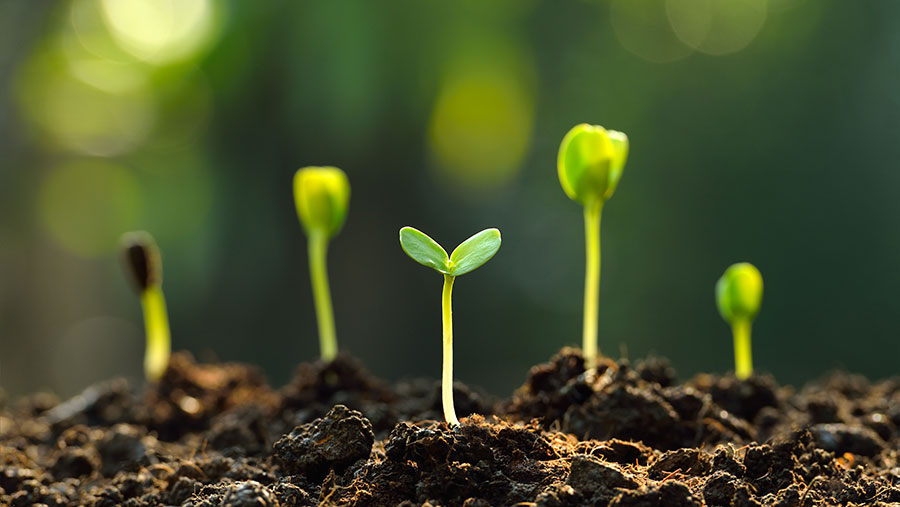Soil science
Healthy soil is the foundation of the food system. It produces healthy crops that in turn nourish people. Maintaining a healthy soil demands care and effort from farmers because farming is not benign. By definition, farming disturbs the natural soil processes including that of nutrient cycling – the release and uptake of nutrients.
Plants obtain nutrients from two natural sources: organic matter and minerals. Organic matter includes any plant or animal material that returns to the soil and goes through the decomposition process. In addition to providing nutrients and habitat to organisms living in the soil, organic matter also binds soil particles into aggregates and improves the water holding capacity of soil. Most soils contain 2-10 percent organic matter. However, even in small amounts, organic matter is very important.
Soil is a living, dynamic ecosystem. Healthy soil is teeming with microscopic and larger organisms that perform many vital functions including converting dead and decaying matter as well as minerals to plant nutrients. Different soil organisms feed on different organic substrates. Their biological activity depends on the organic matter supply.
Nutrient exchanges between organic matter, water and soil are essential to soil fertility and need to be maintained for sustainable production purposes. Where the soil is exploited for crop production without restoring the organic matter and nutrient contents and maintaining a good structure, the nutrient cycles are broken, soil fertility declines and the balance in the agro-ecosystem is destroyed.
Soil organic matter – the product of on-site biological decomposition – affects the chemical and physical properties of the soil and its overall health. Its composition and breakdown rate affect: the soil structure and porosity; the water infiltration rate and moisture holding capacity of soils; the diversity and biological activity of soil organisms; and plant nutrient availability. Many common agricultural practices, especially ploughing, disc-tillage and vegetation burning, accelerate the decomposition of soil organic matter and leave the soil susceptible to wind and water erosion. However, there are alternative management practices that enhance soil health and allow sustained agricultural productivity. Conservation agriculture encompasses a range of such good practices through combining no tillage or minimum tillage with a protective crop cover and crop rotations. It maintains surface residues, roots and soil organic matter, helps control weeds, and enhances soil aggregation and intact large pores, in turn allowing water infiltration and reducing runoff and erosion. In addition to making plant nutrients available, the diverse soil organisms that thrive in such conditions contribute to pest control and other vital ecological processes. Through combining pasture and fodder species and manuring with food and fibre crop production, mixed crop-livestock systems also enhance soil organic matter and soil health. This document recognizes the central role of organic matter in improving soil productivity and outlines promising technologies for improved organic matter management for productive and sustainable crop production in the tropics.
Soil organic matter content is a function of organic matter inputs (residues and roots) and litter decomposition. It is related to moisture, temperature and aeration, physical and chemical properties of the soils as well as bioturbation (mixing by soil macrofauna), leaching by water and humus stabilization (organomineral complexes and aggregates). Land use and management practices also affect soil organic matter.
Farming systems have tended to mine the soil for nutrients and to reduce soil organic matter levels through repetitive harvesting of crops and inadequate efforts to replenish nutrients and restore soil quality. This decline continues until management practices are improved or until a fallow period allows a gradual recovery through natural ecological processes. Only carefully selected diversified cropping systems or well-managed mixed crop-livestock systems are able to maintain a balance in nutrient and organic matter supply and removal.
Farmers can take many actions to maintain, improve and rebuild their soils, especially soils that have been under cultivation for a long time. A key to soil restoration is to maximize the retention and recycling of organic matter and plant nutrients, and to minimize the losses of these soil components caused by leaching, runoff and erosion. However, rebuilding soil quality and health through appropriate farming practices may take several years, especially in dryland areas where limited moisture reduces biomass production and soil biological activity. Thus, the challenge is to identify soil management practices that promote soil organic matter formation and moisture retention and ensure productivity and profitability for farmers in the short term.
FAO recognizes that conservation agriculture can make an important contribution to the agriculture sector through its multiple environmental and economic benefits. Conservation agriculture uses holistic production management systems that promote and enhance agro-ecosystem health, including aboveground and belowground biodiversity, biological cycles, and biological activity. These systems apply specific and precise standards of production based on no- or minimum-tillage techniques and selected cover crops and crop rotations. Their aim is to achieve optimal agro-ecosystems that are socially, ecologically and economically sustainable. Through effective harnessing of agro-ecological processes, conservation agriculture provides an opportunity for reducing external input requirements and for converting low-input agricultural systems into more productive ones. A better understanding of the linkages between soil life and ecosystem function and the impact of human interventions will enable the reduction of negative impacts and the more effective capture of the benefits of soil biological activity for sustainable and productive agriculture.
